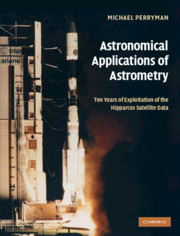Book contents
- Frontmatter
- Contents
- Preface
- 1 The Hipparcos and Tycho Catalogues
- 2 Derived catalogues and applications
- 3 Double and multiple stars
- 4 Photometry and variability
- 5 Luminosity calibration and distance scale
- 6 Open clusters, groups and associations
- 7 Stellar structure and evolution
- 8 Specific stellar types and the ISM
- 9 Structure of the Galaxy
- 10 Solar System and exoplanets
- Appendix A Numerical quantities
- Appendix B Acronyms
- Appendix C Author gallery
- Index of first authors
- Subject index
6 - Open clusters, groups and associations
Published online by Cambridge University Press: 23 November 2009
- Frontmatter
- Contents
- Preface
- 1 The Hipparcos and Tycho Catalogues
- 2 Derived catalogues and applications
- 3 Double and multiple stars
- 4 Photometry and variability
- 5 Luminosity calibration and distance scale
- 6 Open clusters, groups and associations
- 7 Stellar structure and evolution
- 8 Specific stellar types and the ISM
- 9 Structure of the Galaxy
- 10 Solar System and exoplanets
- Appendix A Numerical quantities
- Appendix B Acronyms
- Appendix C Author gallery
- Index of first authors
- Subject index
Summary
Introduction
This chapter considers the Hipparcos contributions to the study of the Population I open clusters (in contrast with globular clusters, treated in Section 9.11), dynamical streams or moving groups, and associations. It should be recognised at the outset that the terms are potentially confusing, lack unambiguous definitions, and are occasionally used interchangeably. Broadly, clusters are reasonably dense concentrations of older stars (typically ≳ 50–100Myr), while associations are more extended collections of younger and more massive stars (typically ≲ 25–50Myr). More precise definitions are given in the box on page 274.
The literature is even more confusing when it comes to the definition of a ‘moving group’. The term is sometimes simply used to denote any system of stars sharing the same space motion, and thus to implicitly include open clusters, globular clusters, and associations. Even in a more restricted sense, excluding these tighter groupings, it has become clear from the Hipparcos results that the term has been used in the past to describe kinematic groups with different origins: thus ‘old moving groups’ (or large-scale stellar or dynamical streams, or ‘superclusters’) appear to include evaporating halos of open clusters, along with resonant dynamical structures in the solar neighbourhood, and systematic velocity structures perhaps imparted by spiral arm shocks. These are treated in Section 6.9. Young moving groups, with ages ≲ 25–50Myr, appear to represent the sparser and more immediate dissipation products of the more youthful associations, and are treated in Section 6.10.
All stars are considered to have been born in dense gas clouds, and clusters and associations appear to formfrommassive dense cores within molecular clouds.
- Type
- Chapter
- Information
- Astronomical Applications of AstrometryTen Years of Exploitation of the Hipparcos Satellite Data, pp. 273 - 338Publisher: Cambridge University PressPrint publication year: 2008



